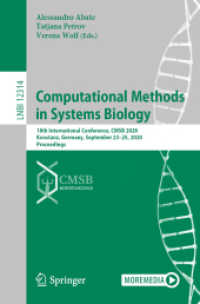Full Description
An Introduction to Lexical Semantics provides a comprehensive theoretical overview of lexical semantics, analysing the major lexical categories in English: verbs, nouns, adjectives, adverbs and prepositions. The book illustrates step-by-step how to use formal semantic tools.
Divided into four parts, covering the key aspects of lexical semantics, this book:
introduces readers to the major influential theories including the syntax-lexical semantics interface theory by Levin and Rappaport and Pinker, the generative lexicon theory by Pustejovsky and formal semantic analyses
discusses key topics in formal semantics including metonymy, metaphor and polysemy
illustrates how to study word meaning scientifically by discussing mathematical notions applied to compositional semantics.
Including reflection questions, summaries, further reading and practice exercises for each chapter, this accessible guide to lexical semantics is essential reading for advanced students and teachers of formal semantics.
Contents
List of Figures
List of Tables
List of Symbols
Part I. Preliminaries
1 Introduction
1.1 Lexical and Compositional Semantics
1.2 Defining Lexeme, Word, and Meaning
1.2.1 Lexeme
1.2.2 Word
1.2.3 Meaning
1.3 Meaning-to-Form Perspective
1.3.1 Lexical Field Theory
1.3.2 Componential Analyses
1.3.3 Conceptual Semantics
1.3.4 Natural Semantic Metalanguage
1.3.5 Prototype Theory
1.3.6 Frame Semantics
1.4 Form-to-Meaning Perspective
1.4.1 Polysemy
1.4.2 Coercion
1.4.3 Metonymy
1.4.4 Metaphor
1.5 Conclusion
Suggested Reading
Practice
2. Methods
2.1 Logical Language
2.2.1 Propositional Calculus
2.2.2 Predicate Calculus
2.2.3 Lambda Calculus
2.2 Model Theory
2.2.1 Truth Relative to a Model
2.2.2 Intensional Models
2.3 Type Theory
2.3.1 Basic and Functional Types
2.3.2 Many-sorted Types
2.4 Lexical Entailments
2.4.1 Grammatical Distributions of Words
2.4.2 Lexical Decomposition
2.4.3 Meaning Postulates
2.5 Conclusion
Suggested Reading
Practice
Part II. Verbs
3. Common Classifications of Verbs
3.1 Ingredients of Verb Semantics
3.1.1 Valency and Argument Order
3.1.2 Event Semantics
3.2 Thematic Roles
3.2.1 Major Theta-Roles
3.2.2 UTAH and the Thematic Hierarchy
3.2.3 Proto Roles
3.3 Aspectual Classes
3.3.1 Aktionsart
3.3.2 Operational Tests
3.4 Event Templatic Structure
3.4.1 Templates and Rroots
3.4.2 Ontological Types of Roots
3.4.3 Consequences of the Bipartite View
3.5 Conclusion
Suggested Reading
Practice
Chapter 4. Types of Verbs
4.1 Many-Sorted Types in the Eventuality Domain
4.1.1 The Logic of Change
4.1.2 The Hierarchy of Many-Sorted Types in the Eventuality Domain
4.2 Process and Event Type Verbs
4.2.1 The Change of State Domain
4.2.2 Manner of Motion and Directed Motion Verbs
4.2.3 Mereology
4.3 Punctual and Durative Event Type Verbs
4.3.1 Semantics of Incrementality
4.3.2 Ditransitive Verbs in the Dative Alternation
4.4 Bounded and Unbounded Durative Event Type Verbs
4.4.1 Variable Telicity and Degree Achievements
4.4.2 The Degree Argument and a Standard of Comparison
4.4.3 A Measure of Change Function
4.5 Conclusion
Suggested Reading
Practice
5. Polysemy and Coercion
5.1 Polysemy
5.1.1 Problems with Verbal Polysemy
5.1.2 The Sense Enumerative Lexical Model
5.1.3 Co-compositionality
5.2 Theoretical Approaches to Polysemy
5.2.1 Literalist Approach
5.2.2 Over-Specification Approach
5.2.3 Under-Specification Approach
5.3 Coercion
5.3.1 Complement Coercion
5.3.2 Aspectual Coercion
5.4 Event-like Behaviors of Stative Verbs
5.4.1 Manner Modification
5.4.2 Analyses Without Coercion
5.5 Conclusion
Suggested Reading
Practice
Part III. Nouns
6. Theories of Nouns
6.1 Names
6.1.1 Criteria of Identity
6.1.2 Names as Rigid Designators
6.1.3 Fictional Names
6.2 Reference to Kind
6.2.1 Interpretation of Bare Nouns
6.2.2 Object, Kind, and Stage
6.2.3 Nominalization and Predicativization
6.3 Qualia Structure
6.3.1 Formal and Constitutive Qualia
6.3.2 Telic and Agentive Qualia
6.4 Complex Types
6.4.1 Dot Objects
6.4.2 Product Types and the Object Elaboration
6.5 Conclusion
Suggested Reading
Practice
7. Types of Nouns
7.1 Object and Substance Type Nouns
7.1.1 Many-Sorted Types in the Domain of Things
7.1.2 The Count Versus Mass Distinction
7.1.3 Lattice-Theoretic Analyses of Mass Nouns
7.1.4 Relationship to the Ontology
7.1.5 Universal Packager and Universal Grinder
7.2 Natural Kind and Artifact Object Type Nouns
7.2.1 Philosophical Debates
7.2.2 Artifact Nouns and Telic Qualia
7.3 Animate and Inanimate Natural Kind Object Type Nouns
7.3.1 The Animacy Hierarchy and Grammatical Effects
7.3.2 Shifting Animacy
7.4 Eventuality Type Nouns
7.4.1 Deverbal Nouns
7.4.2 Abstract Nouns
7.5 Conclusion
Suggested Reading
Practice
8. Metonymy and Metaphor
8.1 Metonymy and its Neighboring Concepts
8.1.1 Diverse Relations in Metonymy
8.1.2 Metonymy and Reference Transfer
8.1.3 Metonymy, Coercion, and Dot Objects
8.2 Theories of Metonymy
8.2.1 Radical Pragmatic Theories
8.2.2 Rule-Based Approaches
8.2.3 An Integrated Approach
8.3 Metaphor as Conceptual Domain Mapping
8.3.1 Comparison- and Categorization-Based Theories
8.3.2 Conceptual Metaphor Theory
8.4 Formal Approaches of Metaphor
8.4.1 A Reductionist Approach
8.4.2 An Intensional Approach
8.4.3 A Pragmatic Rule Approach
8.5 Conclusion
Suggested Reading
Practice
Part IV. Other Lexical Categories
Chapter 9. Types of Adjectives
9.1 Typology of Adjectives
9.1.1 Overview
9.1.2 Intersective Adjectives
9.1.3 Subsective Adjectives
9.1.4 Intensional Adjectives
9.2 Scale Structure
9.2.1 Absolute and Relative Adjectives
9.2.2 Polar Antonyms
9.3 Non-Dimensional or Evaluative Adjectives
9.3.1 Subjectivity
9.3.2 Context-Sensitivity
9.4 The Order of Attributive Adjectives
9.4.1 Inherent and Non-Inherent Qualities
9.4.2 Intersective and Subsective Readings
9.5 Conclusion
Suggested Reading
Practice
Chapter 10. Theories of Adjective Meaning
10.1 Type Homogeneity Versus Heterogeneity Hypotheses
10.1.1 Predicate Versus Modifier Analyses
10.1.2 Doublet Theory
10.1.3 Event-based Theory
10.2 Theories of Vagueness
10.2.1 Vagueness, ambiguity and imprecision
10.2.2 Fuzzy-Logic Theories
10.2.3 Super-Valuation Theories
10.3 Degree-based Theories
10.3.1 Scales and Degrees
10.3.2 Degree Arguments and the Implicit Degree Word
10.4 Predicates of Personal Taste
10.4.1 Relativist Accounts
10.4.2 Contextualist Accounts
10.5 Conclusion
Suggested Reading
Practice
Chapter 11. The Semantics of Adverbs
11.1 Interpretive Issues Regarding Adverbs
11.1.1 Adverbs and Adverbials
11.1.2 Predicational and Functional Adverbs
11.1.3 The Universal Adverb Hierarchy
11.2 Typology of Adverbs
11.2.1 Manner Adverbs
11.2.2 Subject-Oriented Adverbs
11.2.3 Speaker-Oriented Adverbs
11.3 Theoretical Approaches to Adverbs
11.3.1 The Predicate Analysis
11.3.2 The Operator Analysis
11.3.3 Analyses of Speech-Act Adverbs
11.4 Treating Adverbs as Arguments of Verbs
11.4.1 Verb Augmentations
11.4.2 Subject-Oriented Readings
11.5 Conclusion
Suggested Reading
Practice
Chapter 12. The Semantics of Prepositions
12.1 Typology of Prepositions
12.1.1 Do Prepositions Form a Lexical Category?
12.1.2 Locative and directional prepositions
12.1.3 Algebra of path
12.2 Vector Space Semantics
12.2.1 Problems with the Point Ontology
12.2.2 Vector Ontology
12.2.3 Topological Prepositions in Vector Space Semantics
12.2.4 Projective Prepositions in Vector Space Semantics
12.3 Directional Prepositions
12.3.1 Path
12.3.2 Analyses of Directional Prepositions
12.3.3 Aspectual Properties
12.4 Pragmatics of Prepositions
12.4.1 Functional Aspects
12.4.2 Polysemy
12.4.3 Metaphoric Extensions
12.4.4 Primacy of Spatial Relations
12.5 Conclusion
Suggested Reading
Practice
Epilogue
References
Index








